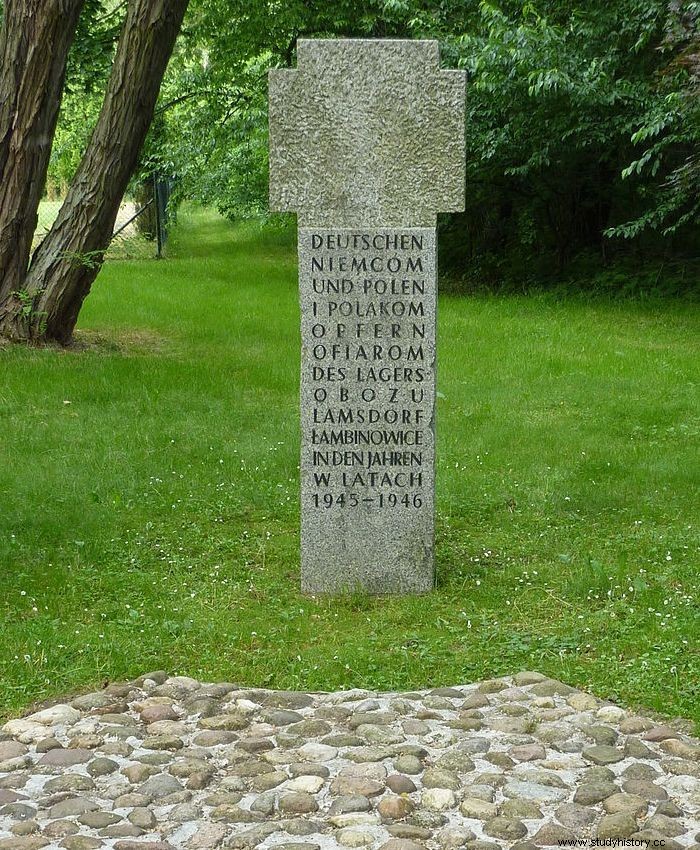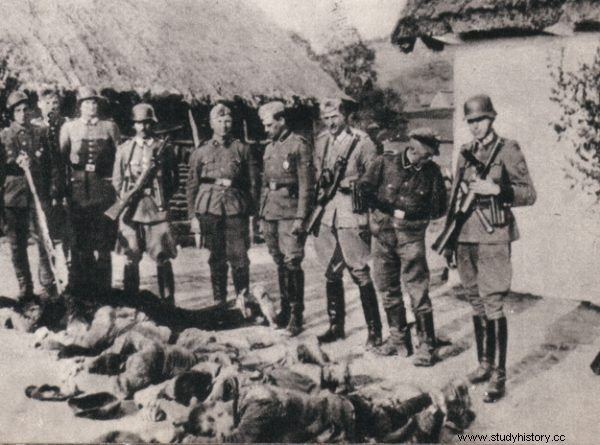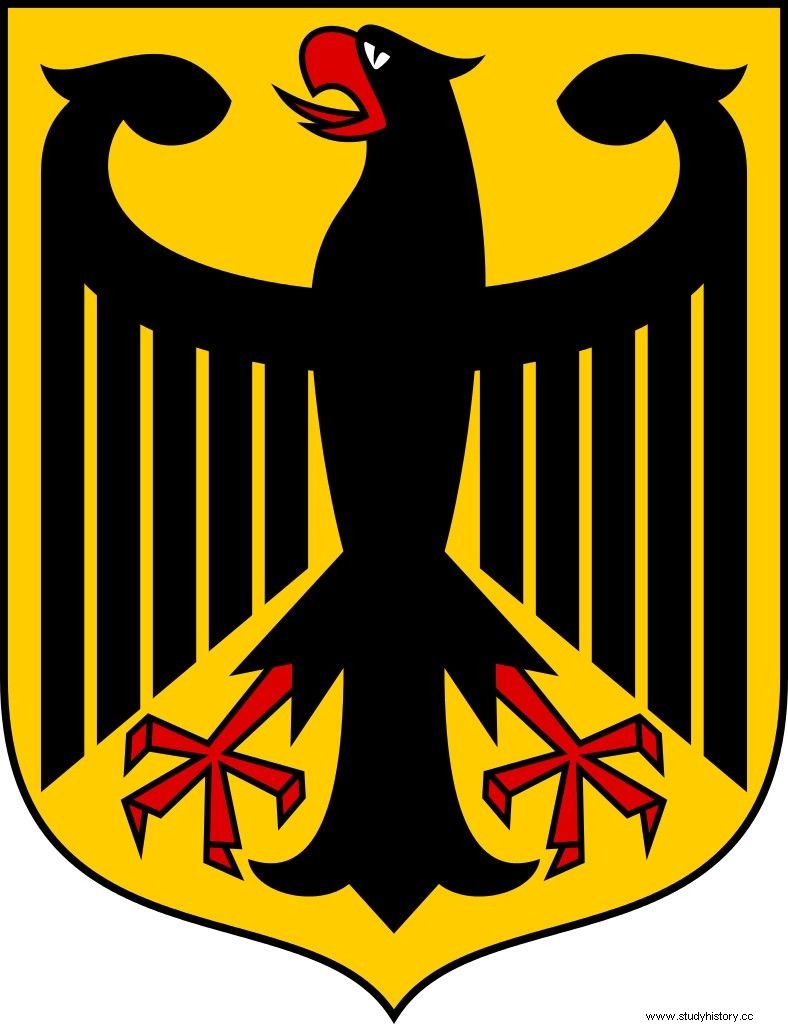The communist authorities knew that Poles did not think about pity. The Germans had to prepare for the worst. And in many cases this is exactly what happened to them. Is it deserved?
1. Lock up in camps
According to the 13th article of the Potsdam Conference, three and a half million Germans from the pre-war borderland were to be resettled to the new frontiers of their country. The document ordered Poles to set up temporary camps, provided with food, water and medical supplies.
The Polish communist authorities, however, had their own plans for German civilians. In 1945, Polish communists took over hundreds of camps, intact by the turmoil of war, abandoned in panic by the retreating Nazi army. The decision not to make them places of martyrdom, but to continue using them, had already been made earlier. It was undertaken almost immediately after the issuance of a manifesto by the Polish Committee of National Liberation on July 22, 1944.
A number of Nazi buildings stretching along the former border were adapted to the needs of the new government. In this way, a whole chain of concentration camps was created, running from the north to Upper Silesia. It was to these places of isolation that more than one hundred thousand Germans ended up in 1945 and 1946.

About 100,000 Germans were sent to concentration camps created by the communists after the war. The photo shows the penitential cross in the Łambinowice camp (photo:Julo, public domain license).
The camps supervised by the Stalinists, however, were nothing like the resettlement camps in which they should not spend more time than necessary to be transported to their new homeland. Civilians were chased without sentence right under the shoes, fists and truncheons of the KBW soldiers. Commanders Salomon Morel, Eryk Karaś, Czesław Gęborski and many others knew no mercy. The latter himself openly admitted that he was in charge of ... a concentration camp.
2. Take me to the mines
The harassment of German civilians took place with the knowledge and consent of the authorities of the Ministry of Public Security. The main architects of the camp system in Poland, i.e. the Minister of Public Security Stanisław Radkiewicz and Teodor Duda, head of the Department of Prisons and Camps, also wanted to use "prisoners" to lift the country from its ruins.
In some places this was done in a civilized and humane manner. This was the case at the Central Labor Camp in Warsaw. The POWs from the Wehrmacht were well fed, not beaten, and even allowed a substitute for administrative independence. A local government was formed there, the so-called Antifa, led by Heinz Grischke.
Work in Silesian mines was carried out on completely different principles. Since the Soviets immediately after the war deported almost two hundred thousand Upper Silesians to Siberia, the Provisional Government decided to resume mining by deporting German civilians to Silesian mines . He drew them from the remotest corners of the "recovered lands". Officials, carpenters, bricklayers, journalists, teachers were sent to the shafts straight from the railway ramp.

During the war, almost every family lost a loved one at the hands of the Germans. No wonder that after the end of the war, the urge for revenge was ubiquitous. The photo shows Polish peasants murdered by the Germans (source:public domain).
For many, the forced retraining to mining turned out to be deadly. As a result of an accident during the extraction, or - more often - of starvation and disease, tens of thousands of people died. The work was completely slave. It was settled between the Ministry of Public Security and the Central Board of the Coal Industry, a body established to manage the free labor force from the Recovered Territories.
3. To tire in the wild
In addition to institutionalized revenge, locked in the official camps of the Ministry of Public Security, there were also spontaneous retaliations on the part of ordinary Poles. Historians pay attention to the so-called wild camps, i.e. pieces of clearings or pastures surrounded by barbed wire by Polish peasants, where the "guilty" of the war were herded and killed . There were over a thousand such places. It happened that they only lasted a few days…
In Polish society, hatred towards the recent occupiers was widespread. Almost every Polish family has lost a loved one at the hands of a German. For years, the new government has used this sense of harm to strengthen its position in the country. How much hatred do you need towards your own Polish nation to do this? - asks rhetorically Hans Klubbe, a former prisoner of the Łambinowice camp.
4. Preferably sell
The huge number of German civilians trapped in communist Poland also became an opportunity for the Stalinists to… make a good deal. They earned money by "letting them out" of a country that was completely closed after the war. The sudden relaxation of the passport policy was usually the result of Polish-German agreements or a game in the Warsaw-Bonn relationship.

The shocking truth about the post-war Polish concentration camps can be found in Marek Łuszczyna's book "Mała zbrodnia" (Znak Horyzont 2017).
The Germans were "sold" in this way for many years, starting in 1947. Those who decided to stay in Poland were also enriched. Officially they have been robbed of their allowances and benefits that they were taken over by their own countrymen over time.
5. Convert to spies
The Polish intelligence service (and later the People's Republic of Poland), which was formed after the war, also had its plans for "Polish Germans". Polish officers rebuilding the famous "two" - Second Division of the General Staff of the Polish Army - were ordered to recruit from among those Germans closed in Poland, whose families were entirely on the other side of the Iron Curtain.
The aim of the agency was to place the largest possible number of "displaced persons" held in Poland in the lower-level administration of Germany. Children, already grown up, previously considered missing, who returned to their families after years of wandering during the war, could avoid the suspicions of Western counterintelligence.

The Polish intelligence, taking advantage of the opportunity, tried to install as many of its agents as possible in Germany (source:public domain).
The plan to gain, thanks to "Polish Germany", new intelligence agents, which the Polish communists had discovered in 1947, was partially successful. We do not know the exact number of spies who were transferred to West Berlin in the post-war period. Only two came by. One of them, Heinz Arnold, even managed to convince the mother who was looking for a child that he was her missing son ... If not for the actions of German agents and the help of the CIA, maybe she would have believed it for the rest of her life.
***
This book shouldn't come out. It won't be easy and fun. It does not prove that Polish concentration camps did not exist. He will not deny the bestiality and cruelty of the Polish guards. He will not say that with the "liberation" by the Red Army, the time of macabre camps in Poland has come to an end. Thanks to Marek Łuszczyna's book you will learn the truth about Polish concentration camps.
Check where to buy “Little Crime. Polish concentration camps ”:
